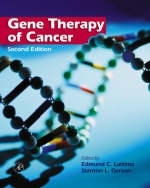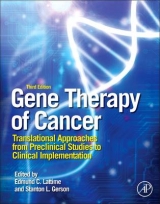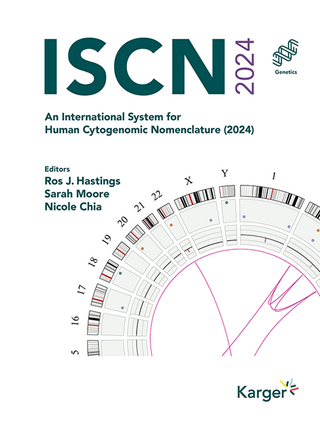
Gene Therapy of Cancer
Academic Press Inc (Verlag)
978-0-12-437551-2 (ISBN)
- Titel erscheint in neuer Auflage
- Artikel merken
The Second Edition of Gene Therapy of Cancer provides crucial updates on the basic science and ongoing research in this field, examining the state of the art technology in gene therapy and its therapeutic applications to the treatment of cancer. The clinical chapters are improved to include new areas of research and more successful trials. Chapters emphasize the scientific basis of gene therapy using immune, oncogene, antisense, pro-drug activating, and drug resistance gene targets, while other chapters discuss therapeutic approaches and clinical applications. This book is a valuable reference for anyone needing to stay abreast of the latest advances in gene therapy treatment for cancer.
Stanton L Gerson is Director of the Case Comprehensive Cancer Center & the National Center for Regenerative Medicine at Case Western Reserve University and Director of University Hospitals Seidman Cancer Center in Cleveland. Dr. Gerson studies DNA repair, stem cells and cancer therapy. He showed that over-expression of the MGMT DNA repair gene could prevent cancer and that a mutant form of MGMT protects hematopoietic stem cells from chemotherapy using lentiviral gene therapy. He has interrogated MGMT, MMR and BER DNA repair pathways as targets for cancer therapy, and proposed that methoxyamine would block base excision repair used in combination with chemotherapy. Dr. Gerson also directed the initial use of mesenchymal stem cells (MSCs) in bone marrow transplantation & in gene therapy. Edmund C. Lattime is Professor of Surgery at the Robert Wood Johnson Medical School and Deputy Director, The Cancer Institute of New Jersey. Dr. Lattime studies tumor immunology and immunotherapy focusing on the tumor-host interaction and the tumor microenvironment. While faculty at Sloan Kettering and then Thomas Jefferson University, his translational studies led to the development and Phase I testing of a novel Vaccinia-GMCSF construct designed to enhance the development of antitumor immunity via infection/transfection of the tumor microenvironment. Based on his mechanistic studies of immune escape mechanisms, his group recently developed and is testing a poxvirus-based immunization strategy, which uses antigen encoding poxvirus delivered to the tumor microenvironment, in patients with locally-advanced pancreatic cancer. Stanton L. Gerson received his M.D. at Harvard Medical School. He was a Resident in Medicine at the Hospital of the University of Pennsylvania, where he became a Fellow in Hematology-Oncology in 1980. He is an Edward Mallinckrodt Jr. Foundation Scholar, and is currently Chief, Division of Hematology/Oncology at Case Western Reserve Univeristy, where he has served since 1983. Dr. Gerson is a member of several major professional and scientific societies and is a principal investigator of funded grants for several philanthropic organizations. He is author or a contributor to over 200 research papers, abstracts, theses and book chapters. Since 1987, Dr. Gerson has been invited to be a guest lecturer at over 40 national and international conferences.
Part I Vectors for Gene Therapy of Cancer
1. Retroviral Vector Design for Cancer Gene Therapy
I. Introduction
II. Applications for Retroviral Vectors in Oncology
III. Biology of Retroviruses
IV. Principles of Retroviral Vector Systems
V. Advances in Retroviral Vector Tailoring
VI. Outlook
References
2. Noninfectious Gene Transfer and Expression Systems for Cancer Gene Therapy
I. Introduction
II. Advantages and Disadvantages of Infectious, Viral-Based Vectors for Human Gene Therapy
III. Rationale for Considering Noninfectious, Plasmid-Based Expression Systems
IV. Gene Transfer Technologies for Plasmid-Based Vectors: Preclinical Models and Clinical Cancer Gene Therapy Trials
V. Plasmid Expression Vectors
VI. Future Directions
References
3. Parvovirus Vectors for the Gene Therapy of Cancer
I. Introduction
II. Biology of Parvoviridae and Vector Development
III. Applications of Recombinant Parvovirus Vectors to Cancer Gene Therapy
IV. Perspectives, Problems, and Future Considerations
References
4. Antibody-Targeted Gene Therapy
I. Introduction
II. Background: Monoclonal Antibodies and Cancer Therapy
III. Recent Advances: Monoclonal-Antibody-Mediated Targeting and Cancer Gene Therapy
IV. Future Directions
References
5. Ribozymes in Cancer Gene Therapy
I. Introduction
II. Ribozyme Structures and Functions
III. Cancer Disease Models for Ribozyme Application
IV. Challenges and Future Directions
References
6. The Advent of Lentiviral Vectors: Prospects for Cancer Therapy
I. Introduction
II. Structure and Function of Lentiviruses
III. Features that Distinguish Lentiviral from Oncoretroviral Vectors
IV. Manufacture of Lentiviral Vectors
V. Possible Applications of Lentiviral Vectors in Cancer Therapy
VI. Conclusions
References
Part II Immune Targeted Gene Therapy
7. Immunologic Targets for the Gene Therapy of Cancer
I. Introduction
II. Cellular (T-Lymphocyte-Mediated) Versus Humoral (Antibody-Mediated) Immune Responses to Tumor Cells
III. Response of CD4+ and CD8+ T Lymphocytes to Tumor Antigens Presented in the Context of Molecules Encoded by the Major Histocompatibility Complex
IV. Response of Tumor-Bearing Individuals to Tumor Antigens
V. Tumor-Associated Peptides as Candidate Targets for Tumor-Specific Lymphocytes
VI. Immunotherapeutic Strategies for the Treatment of Cancer
VII.Conclusions
References
Part IIa Vaccine Strategies
8. Development of Epitope-Specific Immunotherapies for Human Malignancies and Premalignant Lesions Expressing Mutated ras Genes
I. Introduction
II. Cellular Immune Response and Antigen Recognition
III. Pathways of Antigen Processing, Presentation, and Epitope Expression
IV. T-Lymphocyte Subsets
V. ras Oncogenes in Neoplastic Development
VI. Cellular Immune Responses Induced by ras Oncogene Peptides
VII. Identification of Mutant ras CD4+ and CD8+ T-Cell Epitopes Reflecting Codon 12 Mutations
VIII. Anti-ras Immune System Interactions: Implications for Tumor Immunity and Tumor Escape
IX. Paradigm for Anti-ras Immune System Interactions in Cancer Immunotherapy
X. Future Directions
References
Part IIb Dendritic Cell-Based Gene Therapy
9. Introduction to Dendritic Cells
I. Introduction
II. Features of Dendritic Cells
III. Dendritic Cell Subsets
IV. Functional Heterogeneity of Dendritic Cell Subsets
V. Dendritic Cells in Tumor Immunology
VI. Dendritic Cells and Gene Therapy
VII. Conclusions
References
10. DNA and Dendritic Cell-Based Genetic Immunization Against Cancer
I. Introduction
II. Background
III. Recent Advances: Methods of Genetic Immunization
IV. Preclinical Development and Translation to the Clinic
V. Proposed and Current Clinical Trials
VI. Future Directions
References
11. RNA-Transfected Dendritic Cells as Immunogens
I. Introduction
II. Advantages of Loading Dendritic Cells with Genetic Material
III. Viral Versus Nonviral Methods of Gene Transfer 200
IV. RNA Versus DNA Loading of Dendritic Cells
V. RNA Loading of Dendritic Cells
VI. Amplification of RNA Used to Load Dendritic Cells
VII. Uses of RNA-Loaded Dendritic Cells
VIII. Future Directions
References
PART IIc CYTOKINES AND CO-FACTORS
12. In Situ Immune Modulation Using Recombinant Vaccinia Virus Vectors: Preclinical Studies to Clinical Implementation
I. Introduction
II. Generation of Cell-Mediated Immune Responses
III. Cytokine Gene Transfer Studies in Antitumor Immunity
IV. In Situ Cytokine Gene Transfer to Enhance Antitumor Immunity
V. Future Directions
VI. Conclusions
References
13. The Use of Particle-Mediated Gene Transfer for Immunotherapy of Cancer
I. Introduction
II. Background
III. Recent Advances
IV. Issues Regarding Evaluation in Clinical Trials
V. Recent Clinical Trials
VI. Potential Novel Uses and Future Directions
References
PART IId GENETICALLY MODIFIED EFFECTOR CELLS FOR IMMUNE-BASED IMMUNOTHERAPY
14. Applications of Gene Transfer in the Adoptive Immunotherapy of Cancer
I. Introduction
II. Use of Gene-Modified Tumors to Generate Antitumor-Reactive T Cells
III. Genetic Manipulation of T Cells to Enhance Antitumor Reactivity
IV. Genetic Modulation of Dendritic Cells
V. Summary
References
15. Update on the Use of Genetically Modified Hematopoietic Stem Cells for Cancer Therapy
I. Introduction
II. Human Hematopoietic Stem Cells as Vehicles of Gene Transfer
III. Preclinical Studies of Gene Transfer into Hematopoietic Stem Cells
IV. Applications of Genetically Manipulated Hematopoietic Stem Cells to the Therapy of Human Cancer
V. Conclusions
References
Part III Oncogene-Targeted Gene Therapy
16. Clinical Applications of Tumor-Suppressor Gene Therapy
I. Introduction
II. p53
III. BRCA1
IV. Onyx-015 Adenoviruses
V. Summary and Future Work
References
17. Cancer Gene Therapy with Tumor Suppressor Genes Involved in Cell-Cycle Control
I. Introduction
II. p21WAF1/CIP1
III. p16INK4
IV. Rb
V. p14ARF
VI. p27Kip1
VII. E2F-1
VIII. PTEN
IX. BRCA1
X. VHL
XI. FHIT
XII. Apoptosis-Inducing Genes
XIII. Conclusions
References
18. Cancer Gene Therapy with the p53 Tumor Suppressor Gene
I. Introduction
II. Vectors for Gene Therapy
III. p53
IV. Conclusions
References
19. Antisense Downregulation of the Apoptosis-Related Bcl-2 and Bcl-xl Proteins: A New Approach to Cancer Therapy
I. The Bcl Family of Proteins and their Role in Apoptosis
II. Downregulation of Bcl-2 Expression: Antisense Strategies
References
20. Gene Therapy for Chronic Myelogenous Leukemia
I. Molecular Mechanisms Underlying Ph+ Leukemias
II. Therapy
III. Gene-Disruption Methods
IV. Anti-bcr-abl Targeted Therapies
V. Anti-bcr-abl Drug-Resistance Gene Therapy for CML
VI. Conclusion
References
Part IV Manipulation of Drug Resistance Mechanisms by Gene Therapy
21. Transfer of Drug-Resistance Genes into Hematopoietic Progenitors
I. Introduction
II. Rationale for Drug-Resistance Gene Therapy
III. Methyltransferase-Mediated Drug Resistance
IV. Cytidine Deaminase
V. Glutathione-S-Transferase
VI. Dual-Drug-Resistance Approach
VII. Clinical Trials
VIII. Conclusion
References
22. Multidrug-Resistance Gene Therapy in Hematopoietic Cell Transplantation
I. Introduction
II. P-Glycoprotein
III. Targeting Hematopoietic Progenitor Cells for Genetic Modification
IV. Expression of P-Glycoprotein in Murine Hematopoietic Progenitors
V. Expression of P-Glycoprotein in Human Hematopoietic Progenitors
VI. Results of Early Phase I Studies Using MDR1-Transduced Hematopoietic Cells
VII. Overcoming Transduction Inefficiency
VIII. MDR1 Gene Transfer into Humans: Recent Progress
IX. Implication and Future of MDR1 Gene Therapy in Humans
References
23. Development and Application of an Engineered Dihydrofolate Reductase and Cytidine-Deaminase-Based Fusion Genes in Myeloprotection-Based Gene Therapy Strategies
I. Introduction
II. Fusion Genes
III. Development of Clinically Applicable Gene Transfer Approaches
IV. Preclinical Evidence for Myeloprotection Strategies
V. Clinical Applications of Myeloprotection Strategies
VI. Challenges
References
24. Protection from Antifolate Toxicity by Expression of Drug-Resistant Dihydrofolate Reductase
I. Introduction
II. Drug-Resistant Dihydrofolate Reductases
III. Protection from Antifolate Toxicity In Vitro
IV. Protection from Antifolate Toxicity In Vivo: Retroviral Transduction Studies
V. Dihydrofolate Reductase Transgenic Mouse System for In Vivo Drug-Resistance Studies
VI. Antitumor Studies in Animals Expressing Drug-Resistant Dihydrofolate Reductase
VII. Antifolate-Mediated In Vivo Selection of Hematopoietic Cells Expressing Drug-Resistant Dihydrofolate Reductase
VIII. Summary and Future Considerations
References
25. A Genomic Approach to the Treatment of Breast Cancer
I. Introduction
II. Toward a Genomic Approach to Therapy
III. The Use of DNA Microarrays to Understand Drug Resistance
IV. Effects of Genomic-Based Approaches on the Management of Breast Cancer Patients
References
Part V Anti-Aniogenesis and Pro-Apoptotic Gene Therapy
26. Antiangiogenic Gene Therapy
I. Introduction
II. Angiogenesis and its Role in Tumor Biology
III. Antiangiogenic Therapy of Cancer and the Role of Gene Therapy
IV. Preclinical Models of Antiangiogenic Gene Therapy
V. Inhibiting Proangiogenic Cytokines
VI. Endothelial Cell-Specific Gene Delivery
VII. Future Directions in Antiangiogenic Gene Therapy
References
27. VEGF-Targeted Antiangiogenic Gene Therapy
I. Introduction
II. Angiogenesis and Tumor Growth
III. Gene Therapy for Delivery of Antiangiogenic Factors
IV. Antiangiogenic Gene Therapy in the Experimental and Clinical Settings
V. Vascular Endothelial Growth Factor and Receptors
VI. Vascular Endothelial Growth Factor and Angiogenesis
VII. Vascular Endothelial Growth Factor Inhibition by Gene Transfer
VIII. Issues Regarding Clinical Translation of Antiangiogenic Gene Therapy
IX. Conclusion
References
28. Strategies for Combining Gene Therapy with Ionizing Radiation to Improve Antitumor Efficacy
I. Introduction
II. Strategies Using Gene Therapy to Increase the Efficacy of Radiation Therapy
III. Enhancing the Replicative Potential of Antitumor Viruses with Ionizing Radiation
IV. Transcriptional Targeting of Gene Therapy with Ionizing Radiation (Genetic Radiotherapy)
V. Summary and Future Directions
References
29. Virotherapy with Replication-Selective Oncolytic Adenoviruses: A Novel Therapeutic Platform for Cancer
I. Introduction
II. Attributes of Replication-Selective Adenoviruses for Cancer Treatment
III. Biology of Human Adenovirus
IV. Mechanisms of Adenovirus-Mediated Cell Killing
V. Approaches to Optimizing Tumor-Selective Adenovirus Replication
VI. Background: dl1520 (ONYX-015)
VII. Clinical Trial Results with Wild-Type Adenovirus: Flawed Study Design
VIII. A Novel Staged Approach to Clinical Research with Replication-Selective Viruses: dl1520 (ONYX-015)
IX. Results from Clinical Trials with dl1520 (ONYX-015)
X. Results from Clinical Trials with dl1520 (ONYX-015): Summary
XI. Future Directions
XII. Summary
References
30. E1A Cancer Gene Therapy
I. Introduction
II. HER2 Overexpression and E1A-Mediated Antitumor Activity
III. Mechanisms of E1A-Mediated Anti-Tumor Activity
IV. E1A Gene Therapy: Preclinical Models
V. E1A Gene Therapy: Clinical Trials
VI. Conclusion
References
Part VI Prodrug Activation Strategies for Gene Therapy of Cancer
31. Preemptive and Therapeutic Uses of Suicide Genes for Cancer and Leukemia
I. Introduction
II. Therapeutic Uses of Suicide Genes
III. Preemptive Uses of Suicide Genes in Cancer
IV. Creation of Stable Suicide Functions by Combining Suicide Gene Transduction with Endogenous Gene Loss
V. Preemptive Uses of Suicide Genes to Control Graft-Versus-Host Disease in Leukemia
VI. Future Prospects for Preemptive Use of Suicide Genes
References
32. Treatment of Mesothelioma Using Adenoviral-Mediated Delivery of Herpes Simplex Virus Thymidine Kinase Gene in Combination with Ganciclovir
I. Introduction
II. Clinical Use of HSV-TK in the Treatment of Localized Malignancies
III. Challenges and Future Directions
References
33. The Use of Suicide Gene Therapy for the Treatment of Malignancies of the Brain
I. Introduction
II. Retrovirus Vector for HSV-TK
III. Adenovirus Vector for HSV-TK
IV. Herpes Simplex Virus Vectors Expressing Endogenous HSV-TK
V. Promising Preclinical Studies
References
34. Case Study of Combined Gene and Radiation Therapy as an Approach in the Treatment of Cancer
I. Introduction
II. Background of the Field
III. Recent Advances in Herpes Simplex Virus-Thymidine Kinase Suicide Gene Therapy
IV. Combined Herpes Simplex Virus-Thymidine Kinase Suicide Gene Therapy and Radiotherapy
V. Issues Regarding Clinical Trials, Translation into Clinical Use, Preclinical Development, Efficacy, Endpoints, and Gene Expression
VI. Potential Novel Uses and Future Directions
| Erscheint lt. Verlag | 4.4.2002 |
|---|---|
| Verlagsort | San Diego |
| Sprache | englisch |
| Maße | 216 x 279 mm |
| Gewicht | 1520 g |
| Themenwelt | Medizin / Pharmazie ► Medizinische Fachgebiete ► Onkologie |
| Studium ► 2. Studienabschnitt (Klinik) ► Humangenetik | |
| ISBN-10 | 0-12-437551-0 / 0124375510 |
| ISBN-13 | 978-0-12-437551-2 / 9780124375512 |
| Zustand | Neuware |
| Informationen gemäß Produktsicherheitsverordnung (GPSR) | |
| Haben Sie eine Frage zum Produkt? |
aus dem Bereich



